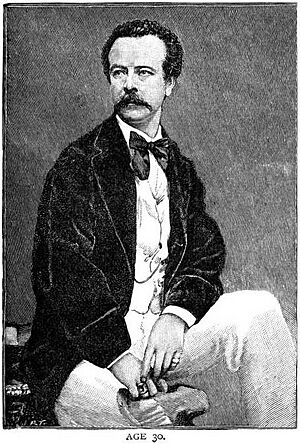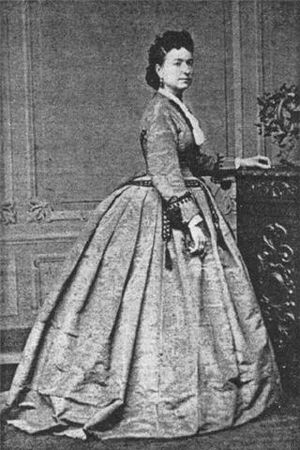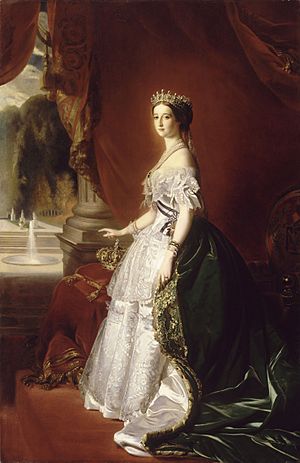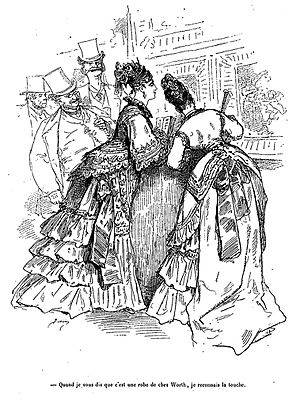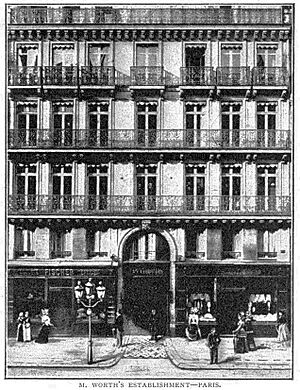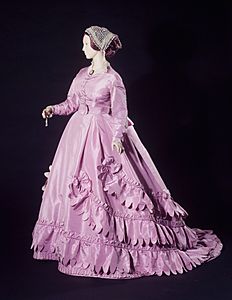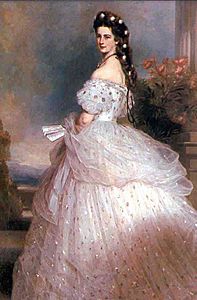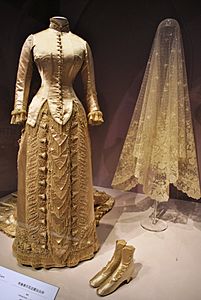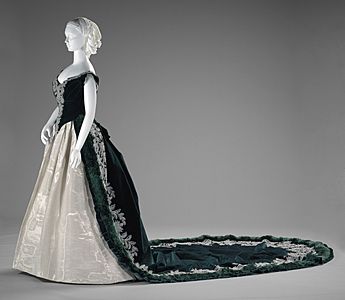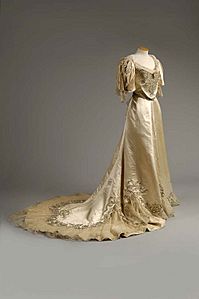Charles Frederick Worth facts for kids
Quick facts for kids
Charles Frederick Worth
|
|
|---|---|
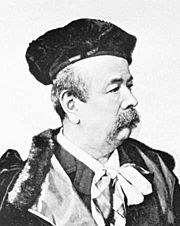 |
|
| Born | 13 October 1825 Bourne, Lincolnshire, England
|
| Died | 10 March 1895 (aged 69) Paris, France
|
| Occupation | Fashion designer |
| Known for | Creating haute couture |
|
Label(s)
|
House of Worth |
| Spouse(s) | Marie Augustine Vernet (1825–1898) |
| Children | Gaston Lucien, Jean Philippe |
| Parent(s) | William Worth and Ann Worth, née Quincey |
| Relatives | Jean-Claude Pascal (great-great grandson) |
Charles Frederick Worth (born October 13, 1825 – died March 10, 1895) was an English fashion designer. He started the House of Worth, which became one of the most important fashion houses of its time. Many fashion experts call him the "father of haute couture" (high fashion). Worth also changed how the fashion business worked.
He opened his fashion salon in Paris in 1858. Soon, kings, queens, and other European royalty became his customers. Wealthy people followed their lead. Worth was a very creative designer. He changed 19th-century dresses to make them more practical for everyday life. Some of these changes were even requested by his most famous client, Empress Eugénie.
Worth was the first to use real people, called live models, to show off his clothes instead of fashion dolls. He also sewed his brand labels into his clothing. Almost all customers visited his salon for a consultation and fitting. This made the House of Worth a popular meeting place for high society. By the end of his career, his fashion house had 1,200 employees. His influence on fashion was huge. The Metropolitan Museum of Art said his "strong self-promotion" earned him the title of the first couturier (a designer of haute couture). By 1870, his name was known not just by royalty but also in women's magazines read by many people.
Worth made dressmaking a respected art. The designer became the person who decided what women should wear. Fashion historian George Walden said in 2002 that Charles Frederick Worth "dictated fashion in France" long before modern designers like Galliano.
Contents
Early Life of a Fashion Pioneer
Charles Frederick Worth was born on October 13, 1825, in Bourne, England. His parents were William and Ann Worth. Some say he was their fifth and last child. He and his brother, William Worth III, were the only children to live to adulthood. Charles' father was a lawyer who lost all the family's money. He left the family in 1836, leaving Charles' mother poor.
At age 11, Charles started working in a printer's shop. A year later, he moved to London. He became an apprentice at the department store Swan & Edgar in Piccadilly. Seven years later, another top British textile store, Lewis & Allenby, hired Worth.
Starting His Fashion Career
In 1846, Charles Frederick Worth moved to Paris. He arrived speaking no French and with only £5 in his pocket. By 1852, he was a sales assistant at Gagelin-Opigez & Cie. This was a famous Parisian company that sold silk fabrics to royal dressmakers. They also sold cashmere shawls and ready-made mantles. Here, he met Marie Vernet, who became his wife in 1851.
Worth began sewing dresses to go with the shawls at Gagelin. At first, his designs were simple. But his excellent sewing skills caught the attention of the store's customers. Eventually, Gagelin let Worth open a dress department. This was his first official step into the world of dressmaking. His ideas were very bold for his employers. He even won awards for his designs at the The Great Exhibition in London in 1851 and the Exposition Universelle in Paris in 1855.
Worth wanted to start his own business. He had a wife and two sons, Gaston Lucien (born 1853) and Jean Philippe (born 1856). He teamed up with a young Swedish businessman, Otto Gustaf Bobergh. In 1858, they opened their business at 7 rue de la Paix, calling it Worth and Bobergh. Marie Vernet Worth was very important from the start. She helped sell clothes and brought in many new customers.
The House of Worth Becomes Famous
Success came quickly. In 1860, Worth designed a ball gown for Princess de Metternich. Empress Eugénie admired it and asked for the dressmaker's name. She demanded to see him the next day. Princess de Metternich later said: "And so...Worth was made and I was lost." Worth quickly became the favorite designer of the Empress, replacing Madame Palmyre.
Worth offered a new way to create high-fashion dresses. He used many different fabrics, some from his old employer Gagelin. He was also an expert at tailoring. Within ten years, his designs were known around the world and in high demand. By the 1870s, his designs appeared in fashion magazines. This meant more people knew about his work.
Worth also changed how customers and clothes makers interacted. Before, the dressmaker would visit the client's home. But Worth's clients usually came to his salon in rue de la Paix. It became a social meeting point for important people. His marketing was also new. He was the first to use live models to show his gowns to clients. His wife was his first model in the 1850s. Some say she was the world's first professional model.
The fashion house started with 50 staff members. Over time, it grew to more than 1,200 staff. This work needed great attention to detail and skill. For example, a Worth bodice might have up to 17 pieces of fabric to fit perfectly. Seamstresses worked in different workshops. They specialized in making sleeves, stitching hems, or making skirts. Most of the sewing was done by hand. However, early sewing machines helped stitch some main seams.
Worth's Important Clients
Worth became Empress Eugénie's official dressmaker. He made most of her fancy evening wear, court dresses, and masquerade costumes. She often called on him to create dresses for her events. For example, for the opening of the Suez Canal in 1869, she ordered 250 Worth dresses. Besides Empress Eugénie, he had many other royal clients, including Empress Elisabeth of Austria.
Rich and important women wanted Worth's amazing creations. Over time, this included American clients. Worth liked working with them because his French was not perfect. He said American women: "have faith, figures, and francs." This meant they trusted him, had good shapes for his designs, and could pay his bills. Many wealthy Americans traveled to Paris to have their entire wardrobe made by Worth. This included morning, afternoon, and evening dresses, as well as nightgowns and tea gowns. He also designed special occasion clothes, like wedding dresses.
Besides high society, the House of Worth also made clothes for famous stars. These included Sarah Bernhardt, Lillie Langtry, and Jenny Lind. They bought clothes for both performances and private wear. Worth's prices were very high for the time. Princess de Metternich, who once said 300-franc dresses were gone after Worth became famous, received a bill for 2,247 francs for one lilac velvet dress.
Worth's Style and Personality
The most famous painting of Charles Frederick Worth shows him wearing a hat, a fur-trimmed cape, and a cravat. He seemed to have adopted this unique style from the 1870s. A visitor in 1874 described Worth wearing "a flowing grey robe that fell to his heels." The visitor also noted Worth was not "Frenchy" and was of medium height with a dark mustache. He looked like a man who lived a balanced life.
While Worth was not scary if you had money, he was not afraid to tell clients what they should wear. He said he had "any amount of trouble with women." They wanted to wear colors that did not suit them or too much decoration. But Worth had the charm to convince his clients. His son Jean Philippe later remembered: "His practiced eye discerned the color and style of robe that would most completely enhance a woman's charm."
Worth's Fashion Innovations
Charles Frederick Worth's dresses were known for their rich fabrics and decorations. He also used elements from historical clothing styles. He made unique pieces for his most important customers. But he also created many designs, shown by live models. These designs could then be custom-made for the client in his workshop. Some of his most important changes in women's fashion were to the shape and length of garments.
Changing Dress Shapes
At the peak of his success, Worth changed the very popular crinoline. This was a stiff petticoat that made skirts very wide. Crinolines had grown so large that women found it hard to do simple things. They struggled to walk through doors, sit down, care for children, or even hold hands. Worth wanted to design a more practical shape for women. So, he made the crinoline narrower and moved its widest part to the back. This freed up a woman's front and sides. Worth's new crinoline was a big success. Eventually, Worth stopped using the crinoline completely. He created a straight dress shape without a defined waist. This became known as the princess line.
Introducing Shorter Hems
Worth also created a shorter hemline, called a walking skirt. Empress Eugénie suggested this because she liked long walks but not long skirts. At first, this ankle-length skirt was seen as too radical or even shocking. But its practical benefits meant it was adopted over time. An example of Worth's 'walking dress' from 1885 is kept at the Metropolitan Museum of Art.
Impact of War and Later Years
The Second French Empire was doing well, and so was Worth's brand, until 1870. That year, the Prussians invaded France. Worth closed his business for a year. He reopened later, but wartime made it hard to find customers. He stayed in business by creating new lines of maternity, mourning, and sportswear. During the siege of Paris, he even turned his salon into a military hospital. At this time, his business partner Bobergh returned to Sweden. Like other fashion designers, the House of Worth was affected by money problems in the 1880s. Charles Frederick Worth found new customers in Britain and America. He also worked to support the struggling French silk industry.
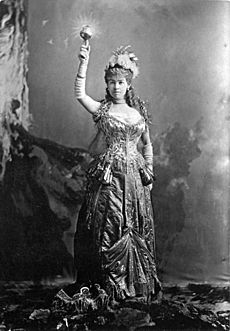
By the late 1880s, Worth had created the features of a modern high-fashion house. He had two seasonal collections each year. He also expanded his brand by selling patterns and fashion plates. One of his biographers noted that he successfully created the idea of the "male 'style dictator'."
Worth's sons, Gaston and Jean, joined the business in 1874. They helped with management, money, and design. This allowed Worth to take more time off in his later years. By this time, he had various health issues, including migraines. On March 10, 1895, Charles Frederick Worth died of pneumonia at age 69. Many newspapers wrote about his death. The Times said it was "singular that Worth...should take the lead in what is supposed to be a peculiarly French art."
Even though he was not in charge day-to-day, he was still active in the House of Worth. At his death, he owned a house in the Champs-Élysées and a villa in Suresnes near the Bois de Boulogne. He was known for giving generously to French charities. He also loved collecting "artistic treasures and curiosities." Worth had clearly become very wealthy. A visitor to his villa in 1874 described many beautiful things. These included faience china, a conservatory full of exotic plants, a winter garden, and stables with perfectly groomed horses. His gardens had statues and stones from Tuileries Palace, the former home of Empress Eugénie.
Charles Frederick Worth's funeral was held at the Protestant Church in the Avenue de la Grande Armée. He was buried at his villa in Suresnes, following the rules of the Church of England. Marie Vernet Worth died three years later.
Worth's Lasting Impact
Even after its founder died, the House of Worth continued. Its most successful years were around 1900. During this time, women often ordered 20-30 gowns at once. By 1897, customers could order clothes by phone, mail, or by visiting one of Worth's stores in London, Cannes, or Biarritz. Worth showed garments at the 1900 Exposition Universelle in Paris, just as he had at earlier big exhibitions. The company's yearly sales were about five million francs around 1900.
Worth created a system for making and selling clothes that shaped the high-fashion industry that followed. A biography for the Museum of the City of New York notes: "Before Worth, the idea of a dress being recognizably the work of its creator didn't exist." He saw clothing as an art form. For the first time, he designed clothes not just for a client's taste. Instead, he designed based on what he thought women should wear. He showed finished designs to clients and buyers, much like modern high-fashion designers do. He also used live models. Worth was also the first designer to put his name on his clothing. He sewed his name into every garment he made. This made him the first person to create a distinct brand logo on clothing.
Worth's Legacy and Collections
The Victoria and Albert Museum in London has an archive of Charles Worth designs. This includes sketches and actual garments. In 1956, the House of Worth donated 23,000 dress drawings to the museum. Two years later, the V&A held a big exhibition. It celebrated 100 years since Charles Frederick Worth started his business.
The Metropolitan Museum of Art also has a collection of his work. This includes several evening gowns.
A Charles Worth Gallery opened in his hometown of Bourne, Lincolnshire. It displays documents, photographs, and items at the Heritage Centre. This center is run by the Bourne Civic Society.
Gallery
-
1865 pink tulle ballgown created for Empress Elisabeth of Austria, as painted by Franz Xaver Winterhalter.
-
Early 1900s court presentation dress from Moyse's Hall Museum – House of Worth was at the height of its success at the turn of the century.
See also
 In Spanish: Charles Frederick Worth para niños
In Spanish: Charles Frederick Worth para niños


